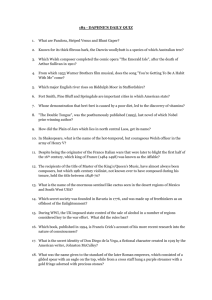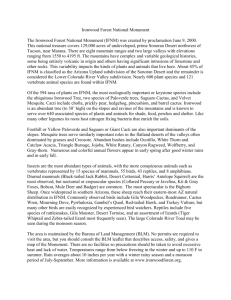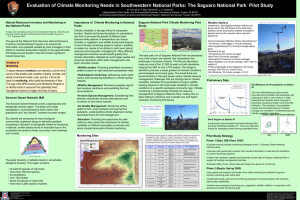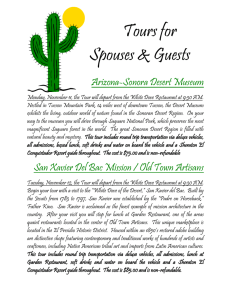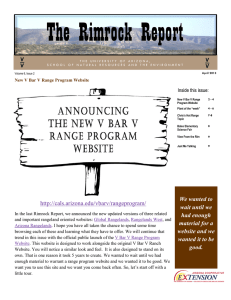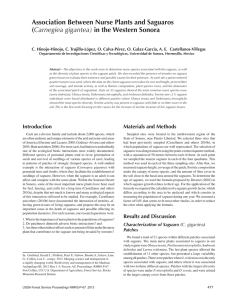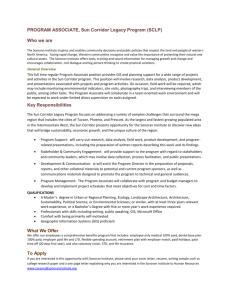Saguaro Life History Information
advertisement
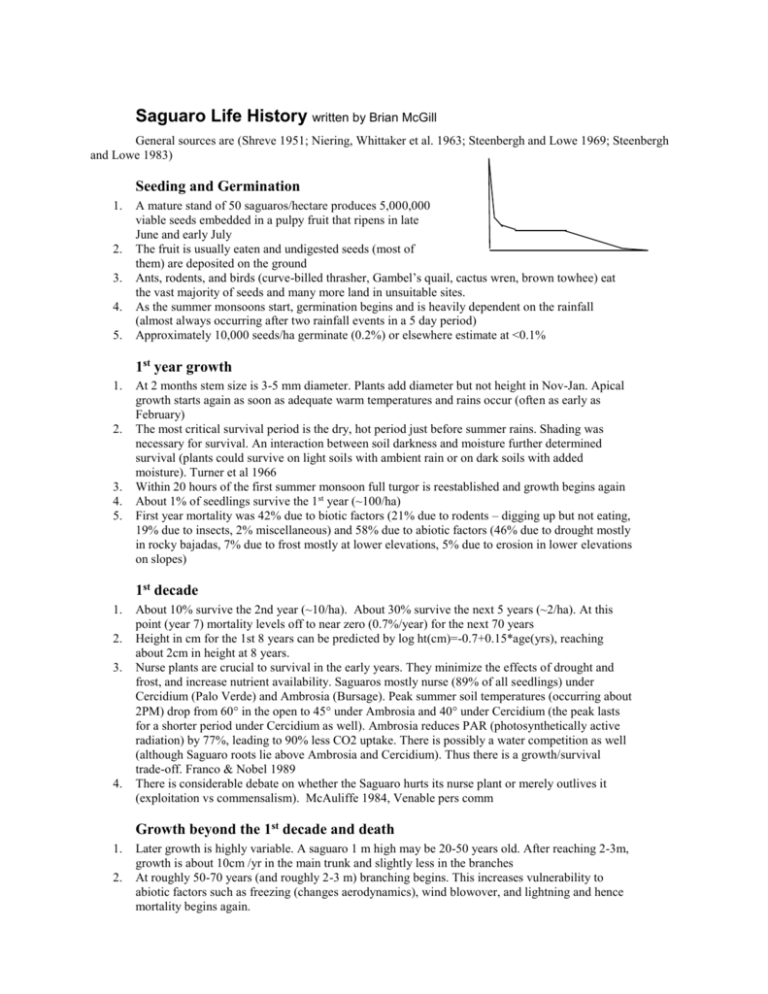
Saguaro Life History written by Brian McGill General sources are (Shreve 1951; Niering, Whittaker et al. 1963; Steenbergh and Lowe 1969; Steenbergh and Lowe 1983) Seeding and Germination 1. 2. 3. 4. 5. A mature stand of 50 saguaros/hectare produces 5,000,000 viable seeds embedded in a pulpy fruit that ripens in late June and early July The fruit is usually eaten and undigested seeds (most of them) are deposited on the ground Ants, rodents, and birds (curve-billed thrasher, Gambel’s quail, cactus wren, brown towhee) eat the vast majority of seeds and many more land in unsuitable sites. As the summer monsoons start, germination begins and is heavily dependent on the rainfall (almost always occurring after two rainfall events in a 5 day period) Approximately 10,000 seeds/ha germinate (0.2%) or elsewhere estimate at <0.1% 1st year growth 1. 2. 3. 4. 5. At 2 months stem size is 3-5 mm diameter. Plants add diameter but not height in Nov-Jan. Apical growth starts again as soon as adequate warm temperatures and rains occur (often as early as February) The most critical survival period is the dry, hot period just before summer rains. Shading was necessary for survival. An interaction between soil darkness and moisture further determined survival (plants could survive on light soils with ambient rain or on dark soils with added moisture). Turner et al 1966 Within 20 hours of the first summer monsoon full turgor is reestablished and growth begins again About 1% of seedlings survive the 1st year (~100/ha) First year mortality was 42% due to biotic factors (21% due to rodents – digging up but not eating, 19% due to insects, 2% miscellaneous) and 58% due to abiotic factors (46% due to drought mostly in rocky bajadas, 7% due to frost mostly at lower elevations, 5% due to erosion in lower elevations on slopes) 1st decade 1. 2. 3. 4. About 10% survive the 2nd year (~10/ha). About 30% survive the next 5 years (~2/ha). At this point (year 7) mortality levels off to near zero (0.7%/year) for the next 70 years Height in cm for the 1st 8 years can be predicted by log ht(cm)=-0.7+0.15*age(yrs), reaching about 2cm in height at 8 years. Nurse plants are crucial to survival in the early years. They minimize the effects of drought and frost, and increase nutrient availability. Saguaros mostly nurse (89% of all seedlings) under Cercidium (Palo Verde) and Ambrosia (Bursage). Peak summer soil temperatures (occurring about 2PM) drop from 60 in the open to 45 under Ambrosia and 40 under Cercidium (the peak lasts for a shorter period under Cercidium as well). Ambrosia reduces PAR (photosynthetically active radiation) by 77%, leading to 90% less CO2 uptake. There is possibly a water competition as well (although Saguaro roots lie above Ambrosia and Cercidium). Thus there is a growth/survival trade-off. Franco & Nobel 1989 There is considerable debate on whether the Saguaro hurts its nurse plant or merely outlives it (exploitation vs commensalism). McAuliffe 1984, Venable pers comm Growth beyond the 1st decade and death 1. 2. Later growth is highly variable. A saguaro 1 m high may be 20-50 years old. After reaching 2-3m, growth is about 10cm /yr in the main trunk and slightly less in the branches At roughly 50-70 years (and roughly 2-3 m) branching begins. This increases vulnerability to abiotic factors such as freezing (changes aerodynamics), wind blowover, and lightning and hence mortality begins again. 3. 4. 5. 6. 7. These abiotic factors cause a roughly linear die-off with most saguaros most dead by about 150 and a few lasting into their 3rd century. Biotic factors rarely cause death in mature saguaros. An old saguaro may well have 40 woodpecker holes that it has successfully callused off. Bacterial infections can kill if they occur in frost-damaged tissue or due to a broken arm in the moist summer. It has been shown that the northern geographic limit is set by the limit at which infrequent freezing temperatures persist for more than 24 hours. As you move north within the saguaro range, diameter increases and # of flutings decreases (increasing surface/volume ratio). Nobel (1980, 1982) showed that Saguaro has the same tissue resistance to freezing that Stenocereus has (which is significantly lower than some Opuntias), but the larger diameter and greater number of spines allows it to resist freezing better and extend its range further north. Overall, saguaros are limited in range to the north by the increasing freezing temperatures as you go up the Mogollon rim to the Colorado plateau, to the east again by temperatures as you rise into the Rockies and its southern extensions, to the west by the Colorado river due to increasing aridity (a few sites just across the river in California occur). Saguaros extend to the south in mainland Mexico (but not the baja) down to about Guaymas, and presumably are limited by competition from more tropical species. In an attempt to find human causes for decline in Saguaros Kolberg & Lathja (1997 2 papers) showed that while soil and tissue Cu levels are higher near smelters, it is not high enough to cause toxicity. Moreover, browning is uncorrelated with Cu but appears to be a result of tissue scorching from the sun. Reproduction 1. 2. You all know what a saguaro flower looks like. It is white, many-petalled with a hypanthium (corolla fused onto ovary). Flowers come out in the evening and last into the early morning the next day. They occur at the apex of the plant. Pollination is a mixture of nocturnal (nectar feeding bats) and diurnal (bees and doves) animals. Bees are relatively ineffective pollinators (Alcorn, McGregor et al. 1961; McGregor, Alcorn et al. 1962; Fleming, Tuttle et al. 1996; Fleming 2000) Plant animal interactions 1. 2. 3. In addition to pollination, a number of animals depend on saguaros. It has recently been shown that white-winged doves depend heavily on saguaros for water and nutrition in the driest/hottest part of the year (just before monsoons when saguaros flower and fruit) There is an entire ecosystem on decaying saguaros including drosophila, beetles, and (I believe) a lizard that lives on the bugs that live on the dying saguaro Many native human populations depended on the saguaro. Population dynamics For discussion on the two papers Paleohistory A packrat midden site (Eagle Mountain) just south of the Mogollon rim and at an elevation/precipitation level intermediate between Phoenix and Tucson was studied. It found that: 22000-~14000 ya pine/sagebrush with oak/juniper 14000-10000 ya oak/juniper 10000-present Ephedra, Acacia, Carnegia, Ferocactus 7000-present above + Larrea, Encelia, Cercidium, Opuntia The proffered explanation for the present day community disjunction is that Acacia, Carnegia, and Ferrocactus are bird dispersed, while Larrea, Encelia and Cercidium are all rodent dispersed and hence dispersal limitations drove this pattern (MacAuliffe and Van Devender 1998) A 120 year study of an untouched area (MacDougal Crater) shows that (Turner 1990) Larrea & Cercidium declined ~60% first half this century, no recruitment since Carnegia increase 4X (and had three major recruitment episodes in 1790-1960) Prosopis increased 200X, Encelia increased greatly This is proported to be due to drought 1936-1964 and that establishment is related to heavy preciptation? Niche Cactus in general: excel at handling water stress due to stem succulence and CAM but lose ability to compete for light for these same reasons (and hence are found in dry open areas) wide, shallow root systems and can idle without water for extended periods and hence excel at the temporal niche of using briefly available water Slopes and areas facing southwest dry faster and hence are where Saguaro dominate Saguaro in particular relative to other columnar cacti tend to: Have a larger stem and more spines making it more cold tolerant (hence found further north and further up slopes and even in valleys when soil appropriate) Have shallower roots than some (e.g. vs senita) and hence prefers coarse, rocky soils that drain quickly and that provide structural support despite shallow roots Yeaton & Cody 1979; Parker 1988 Bibliography Alcorn, S. M., S. E. McGregor, et al. (1961). “Pollination of Saguaro cactus by doves, nectar-feeding bats, and honey bees.” Science 133(19 May): 1594-1595. Fleming, T. (2000). “Pollination of cacti in the Sonoran desert.” American Scientist 88(5): 432-439. Fleming, T., M. Tuttle, et al. (1996). “Pollination biology and the relative importance of nocturnal and diurnal pollinators in three species of Sonoran desert columnar cacti.” Southwestern Naturalist 41(3): 257-269. Franco, A. and P. Nobel (1989). “Effect of nurse plants on the microhabitat and growth of cacti.” Journal of Ecology 77: 870-886. Goldberg, D. and R. Turner (1986). “Vegetation change na dplant demography in permanent plots in the Sonoran desert.” Ecology 67(3): 695-712. Kolberg, K. and K. Lathja (1997). “Population dynamics and trace metal biogeochemistry of the saguaro cactus (Carnegiea gigantea) in the Sonoran desert.” Ecoscience 4(2): 223-231. Lajtha, K., K. Koberg, et al. (1997). “Ecophysiology of the saguaro cactus (Carnegia gigantea) in the Saguaro National Monument: relationship to symptoms of decline.” Journal of Arid Environments 36: 579-590. McAuliffe, J. (1984). “Sahuaro-nurse tree associations in the Sonoran desert - competitive effects of Sahuaros.” Oecologia 64(3): 319-321. McAuliffe, J. R. and T. R. Van Devender (1998). “A 22,000 year record of vegetation change in the northcentral Sonoran desert.” Palaeogeography, Palaeoclimatology, Palaeoecology 141(253-275). McGregor, S., S. M. Alcorn, et al. (1962). “Pollination and pollinating agents of the Saguaro.” Ecology 43(2): 259-266. Niering, W., R. Whittaker, et al. (1963). “The Saguaro: a population in relation to its environment.” Science 142(4 Oct): 15-23. Nobel, P. S. (1980). “Morphology, surface temperatures, and Northern limits of columnar cacti in the Sonoran desert.” Ecology 61(1): 1-7. Nobel, P. S. (1982). “Low-temperature tolerance and cold hardening of cacti.” Ecology 63(6): 1650-1656. Parker, K. C. (1988). “Environmental relationship and vegetation associates of columnar cacti in the northern Sonoran desert.” Vegetatio 78: 125-140. Parker, K. C. (1988). “Environmental relationships and vegetation associates of columnar cacti in the northern Sonoran Desert.” Vegetatio 78: 125-140. Pierson, E. A. and R. M. Turner (1998). “An 85-year study of Saguaro (Carnegiea gigantea) demography.” Ecology 79(8): 2676-2693. Shreve, F. (1951). Vegetation of the Sonoran Desert - Volume I. Washington, DC, Carnegie Institution of Washington. Steenbergh, W. F. and C. H. Lowe (1969). “Critical factors during the first years of life of the Saguaro (Cereus giganteus) at Saguaro National Monument, Arizona.” Ecology 50(5): 825-834. Steenbergh, W. F. and C. H. Lowe (1983). Ecology of the Saguaro: III Growth and demography. Washington DC. Turner, R. M. (1990). “Long-term vergetation change at a fully protected Sonoran desert site.” Ecology 7(2): 464-477. Turner, R. M., S. M. Alcorn, et al. (1950). “Mortality of transplanted Saguaro seedlings.” Ecolog 50(5): 835-844. Turner, R. M., S. M. Alcorn, et al. (1966). “The influence of shade, soil, and water on Saguaro seedling establishment.” Botanical Gazette 127(2-3): 95-102. Wolf, B. O. and C. Martinez del Rio (2000). “Use of saguaro fruit by white-winged doves: isotopic evidence of a tight ecological association.” Oecologia 124: 536-543. Yeaton, R. I. and M. L. Cody (1979). “The distributionof cacti along environmental gradients in the Sonoran and Mohave deserts.” Journal of Ecology 67: 529-541.
